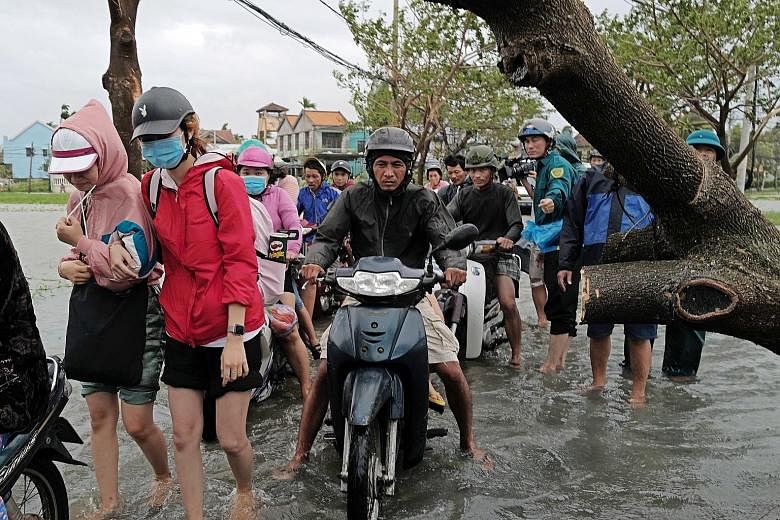A series of storms buffeting Vietnam this month, claiming the lives of 130 people and leaving dozens missing so far, has underscored the added complexity of responding to disasters during the Covid-19 pandemic.
Typhoon Molave, packing winds of 125kmh, is the fourth big storm to hit the country's central provinces this month, further immiserating the 800,000 people already affected by flooding in the region, as well as in Cambodia and Laos.
In such emergencies, teams of logistics and communications specialists would normally be dispatched from neighbouring countries to help pave the way for the delivery of supplies, and search and rescue missions. This time, owing to the pandemic, Vietnamese officials have declined such offers of help.
"Vietnam made clear that no personnel could come - only items," said Ms Adelina Kamal, executive director of the Asean Coordinating Centre for Humanitarian Assistance on Disaster Management, better known as the AHA Centre.
To be sure, Vietnam has seen worse and may be able to manage the disaster itself, with or without a pandemic. In 2017, more than a dozen storms triggered floods and landslides that claimed nearly 400 lives and caused the equivalent of $3.5 billion in damage.
Last week, the AHA Centre arranged the airlift of 1,300 kitchen sets, consisting of utensils for cooking and meals, from Subang, Malaysia, the location of one of three Asean regional stockpiles. But none of the more than 320-strong Emergency Rapid Assessment Team who were already outside Vietnam were permitted to enter.
As Covid-19 threatens to drag on for many more months, emergency response officials will need to rely more on local talent if the pandemic deters the arrival of help from overseas.
There could be a repeat of recent years that saw multiple large-scale disasters, at a time when disaster mitigation officials may already be distracted with Covid-19.
Damage caused by storms and typhoons in the western Pacific in 2018, including Typhoon Mangkhut which claimed over 130 lives in the Philippines and China, set a record of US$30.2 billion that year, only to be bested by the damage figure the following year which topped US$34 billion (S$46 billion).
More than 4,300 lost their lives in earthquakes and tsunamis that stuck Indonesia's Central Sulawesi in September 2018. Ms Adelina recalls daily morning meetings in Balikpapan, East Kalimantan to plan airlifts using military aircraft to ferry supplies to victims. "Without physical coordination, if we have multiple disasters like in 2018, it's going to be difficult," she said.
Flooding in Vietnam notwithstanding, this year has been quiet. The airlift to Vietnam this month was AHA Centre's first for a natural disaster since the onset of the pandemic in March, Ms Adelina said.
The AHA Centre was established in 2011. By now, teams there have notched up sufficient experience and familiarity to cope with limitations stemming from the pandemic, said Ms Adelina, stressing the need for preparation to deal with disasters. "We have to start the planning from now on," she said. "People may have been clouded by Covid-19. Maybe they are praying that there won't be a disaster. But we are a disaster-prone region."
Dr Raditya Jati, head of data, information and disaster communication at Indonesia's National Disaster Management Agency, said the central government is pushing local governments to identify populated areas prone to flooding and landslides, and temporary shelters that can minimise crowding.
Floods in West Jakarta last month were something of a dress rehearsal of a large-scale disaster, with officials handing out masks and enforcing social distancing, which Dr Raditya said prevented clusters of Covid-19 infections.
Decisions to admit foreign emergency workers remain on a case-by-case basis, he said. "We are a big country. There is a challenge to access the whole country."

